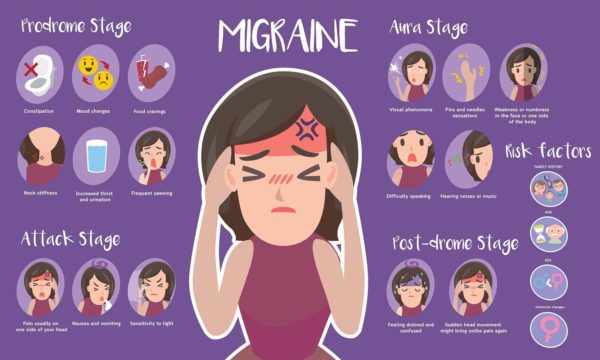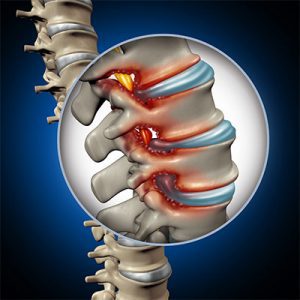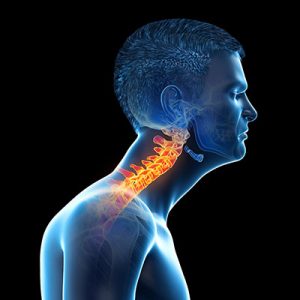Migraines and Chiropractic Care: What You Need to Know

More than 35 million Americans each year are afflicted by chronic migraines. Unlike a headache, a migraine has a wide variety of life-interrupting symptoms that can drastically decrease the quality of one’s life.
Some of the symptoms that migraines can create are vision loss, head pain, pins and needles in the arms and legs, weakness and numbness, visual distortion, and even difficulty speaking.
Additionally, migraines can create symptoms that affect the digestion, the heart rate, and the musculature of the body. Before a migraine even begins, there are usually some signs that are noticeable. These signs appear during the prodrome phase.
The prodrome phase is often recognizable by regular migraine sufferers, who learn the patterns of their body’s “tells” prior to a migraine.
While some people can identify this stage and then take action to ward off the migraine attack, it’s not a realistic expectation for all of the millions of migraine sufferers who experience regular, life-interrupting migraines.
Instead, most sufferers are “out of commission” for hours or days as a result of their attacks. If you or someone you love is suffering from migraines, keep reading to learn more and how chiropractic care can help.
Migraines may be caused by something different for everyone
Research shows that what causes a migraine may be as different as the person who is suffering from them.
The most common consensus among scientists is that migraines are likely triggered by stress, but the way that stress appears in each person’s body may vary depending on their lifestyle, genetics, and environment.

Because of this, it’s not surprising to see that migraine symptoms vary widely from person to person, but certain things stay the same.
There are four significant stages of a migraine attack. This is the prodrome phase, the aura, the attack phase, and the post-drome phase.
Everyone won’t experience these stages in the same way (and some people don’t experience the aura at all), but it’s important to understand the cycle of the body and how it comes on to fully appreciate the ameliorating effect of chiropractic care.
The Prodrome Phase
Completely different from the actual attack itself, the prodrome phase occurs up to two days before the classic symptoms of a migraine begin.
In the prodrome phase, a migraine sufferer may experience mood swings, constipation, the need for more food, stiffness in the neck and body, and an increased need to consume more liquids and urinate more.
Additionally, frequent and irregular yawning can be experienced in the prodrome phase—even if the sufferer doesn’t feel tired. The prodrome phase “kicks in” hours to days before the attack begins.

Those who experience chronic and regular migraines may benefit from recognizing these symptoms to begin winding down any excess stress they may be experiencing, but this often isn’t enough to stave off the migraine completely.
Precautionary measures that may help decrease the likelihood of an attack include increasing hydration, receiving more sleep, or for some, utilizing over-the-counter or prescription pain medications.
Chiropractic care can be very helpful in stopping a migraine attack during the prodome phase.
The Aura
Not all migraine sufferers will experience the aura stage of a migraine, but if you do, you’ll be able to recognize it unmistakably.
The aura can be a scary part of a migraine, as it has some similarities to vertigo, stroke, and epilepsy.
Visual distortions are a common part of the aura phase of a migraine. A person may experience the same visual distortions during each migraine, or it may change.
These distortions include flickering lights, beams, spots of light (think of a lens flare effect in a film), blind spots in one or both eyes, difficulty focusing, or blurred vision.

Additionally, in more heightened examples, hallucinations, confusion, or random past memories may appear during the aura stage of a migraine.
There are many types of distortions that occur during the aura phase of a migraine, and they aren’t limited to only visual distortions.
You may feel phantom tingles and sensations in different parts of the body, including on the face or in the hands.
It may also be difficult to speak clearly or understand what people are saying to you. Migraines can impact your ability to concentrate, interpret written words, or think clearly.
Chiropractic care can still offer relief, including during the aura phase of a migraine headache.
This depends on the severity of the aura, the amount of stress the sufferer is experiencing, and lifestyle and environmental factors.
The Attack Phase
The attack phase is the most commonly associated part of the migraine headache.
With regard to severity, migraines typically outrank headaches significantly, due to the overall intensity of the migraine and its ability to affect many parts of the body simultaneously.
During the attack phase of a migraine, a headache often appears. This headache can begin above or between the eyes and often becomes more severe on one side of the head or face.
Migraine headaches will often be accompanied by throbbing, which likely will increase when the sufferer bends forward or engages in any meaningful physical activity.
During the attack phase of a migraine, moving and attempting to remain active will likely not be helpful, instead only increasing stress during the migraine.
Typically, migraine sufferers will find that they are more sensitive to light, sound, and smell during the height of the attack phase.
Because of this, they’re likely to feel lightheaded, faint, nauseous, and experience digestive discomfort. A migraine in its attack phase can make carrying on with your daily activities difficult or impossible.
The attack phase often immobilizes the sufferer and makes it hard or even impossible to enjoy their lives during the period of time in which it occurs.
The Post-Drome Phase
During the post-drome phase of a migraine, your body is recovering. During this phase, most migraine sufferers feel relieved, while also experiencing residual effects of the migraine.
They may feel drained, sluggish, and even confused. It’s likely that they’ll feel pain if they sit up too quickly, lean forward, or engage in any activity that drives blood flow to the head region.
How Chiropractic Helps with Migraines
Chiropractic care has been associated with substantial (and complete) improvement in the frequency and severity of migraines experienced by regular sufferers.
Although researchers still don’t know exactly what factors cause migraines aside from stress and sleep deprivation, there are strong associations between the condition of the central nervous system (brain and spine) and migraine pain and severity.
Because of the therapeutic effect of chiropractic care on the central nervous system, it’s possible that this is due to the connection between the CNS and the rest of the body.
When the body receives chiropractic care, the treatment helps to regulate the function of the central and peripheral nervous systems.
This regulating effect can happen through direct contact between the treatment and the body (on the joints, muscles, and tissues) or through indirect contact (as the result of movement and detoxification created by chiropractic treatment).
The nervous system is stimulated and reset from chiropractic treatment, which allows it to return to an ideal baseline of health and produce the balancing effect for which it is widely known.
At Your Appointment
If you live in the Virginia Beach area and you or a loved one suffers from migraines, it’s time for you to receive the relief that you deserve. Dr. Samantha Coleman is a Chiropractic BioPhysics® certified chiropractor with over a decade of experience in the field.
Having helped thousands of patients experience a reduction in their worst symptoms and conditions, Dr. Coleman and her team are confident that the relief you need is only as far away as your individualized treatment plan.
With the most advanced technology available, Dr. Coleman and team will help to create a personalized treatment plan designed to meet your unique needs.
If you’re ready to experience the benefits of chiropractic care for migraines, for back pain, neck pain, digestive issues, and more, then book your appointment today

Similar Posts
Free Initial Consultation
Stop living with pain and discomfort. Contact us to schedule your free initial appointment.
Request an appointment online, or call 757-271-0001







